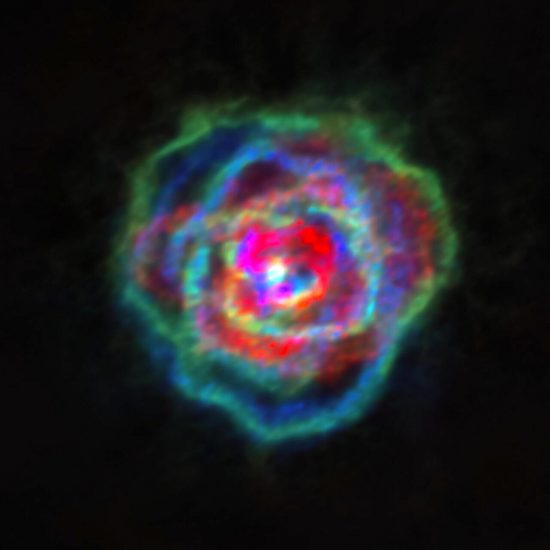
November 18, 2020
Red giant stars can resemble planetary nebulae.
Astronomers think that planetary nebulae are created when shockwaves “blow” through them. Those “winds” come from nearby exploding stars. In some cases, a nebula will emit X-rays, or extreme ultraviolet light, so the consensus opinion is that nuclear fusion is occurring in the cloud. A planetary nebula can result from a dying star, as well—one that has exhausted its hydrogen/helium fuel supply, collapsing under gravitational pressure. It is thought that the star’s implosion rebounds off its core, throwing massive amounts of star stuff into space.
Billows of dusty plasma were first called “planetary nebulae”, because in the early days of astronomy, with primitive metal mirrors, they appeared to be round and faintly greenish, similar to the planet Uranus. They were called “planetary” because it was thought that were also gas giants. Nebulae come in all shapes and sizes, including elliptical shapes or helical spirals.
Observations from space-based telescopes reveal more details, including filaments, braids, overlapping rings, stacked rings, and hourglass shapes; along with “tubes” extending for many light-years. It soon became obvious that nebulae are, essentially, cylinders and not spheres.
According to a recent press release, “…massive planets or other objects orbiting dying stars help stir up stellar winds and shape planetary nebulae…”
In their study of red giant stars, astronomers did not see “spherical stellar winds”. Instead, the emissions were shaped like petals and lobes. As reported, they resembled planetary nebulae.
Astrophysicists do not know how stars “shrug off” their outer layers or how they eject lobate structures. The reason for the misunderstanding is that nebulae are not composed of hot gas, but plasma. Gases obey the laws of kinetic motion: molecules bump into each other due to thermal energy, or they are accelerated by the impetus imparted for other fast-moving particles.
Plasma behaves in accordance with the laws of electricity rather than Newtonian physics. Stars are created within Birkeland currents that flow in a great circuit through the galaxy. The Bennett pinch effect squeezes plasma inside these cosmic “transmission lines” in space, igniting stars and forming toroidal currents around the stellar equators. It is actually the electrical current density that causes the plasma in nebular rings and shells to glow.
Since plasmas in laboratory experiments form cellular structures separated by thin walls of opposite charge—double layers—it is probable that the same thing happens in nebulae. As Hannes Alfvén wrote:
“…space in general has a ‘cellular structure’, although this is almost impossible to observe unless a spacecraft penetrates the ‘cell walls’ (current sheets). This means that in distant regions, we cannot hope to detect the cell walls directly. Nor can we tell the size of the cells. It is unpleasant to base far-reaching conclusions on the existence of a structure which we cannot detect directly. But the alternative is to draw far-reaching conclusions from the assumption that in distant regions, the plasmas have properties which are drastically different from what they are in our own neighborhood.” (Alfvén, H., Cosmic Plasma, Chapter II, Electric Currents in Space Plasmas).
Also, as Dr. Donald Scott makes clear in his book The Electric Sky, a planetary nebula results from electrical overload in a star: a normal star flaring up from abnormal electrical stress. The observed filamentary, cellular and toroidal structures are characteristic of plasma behavior.
Stephen Smith












